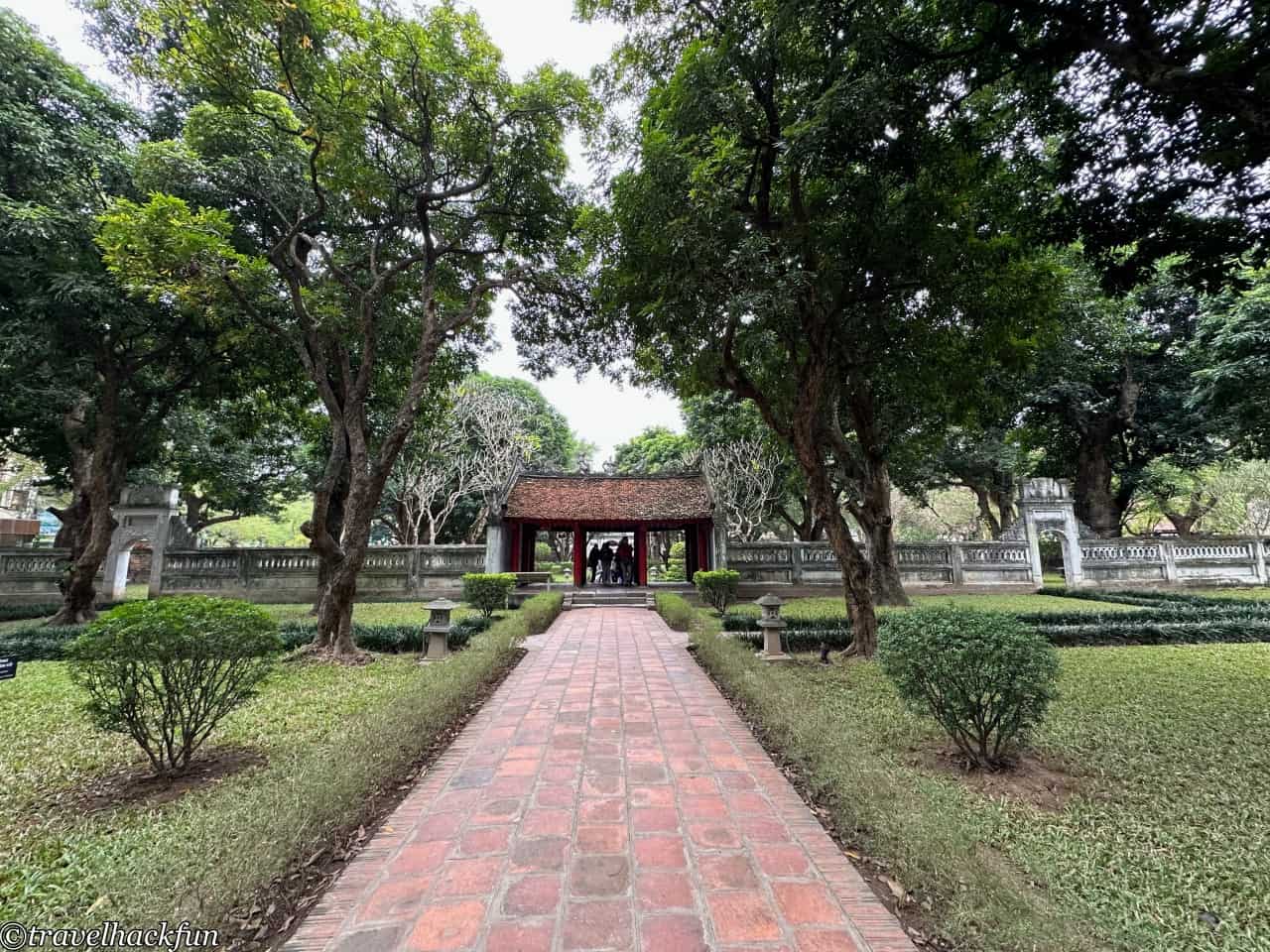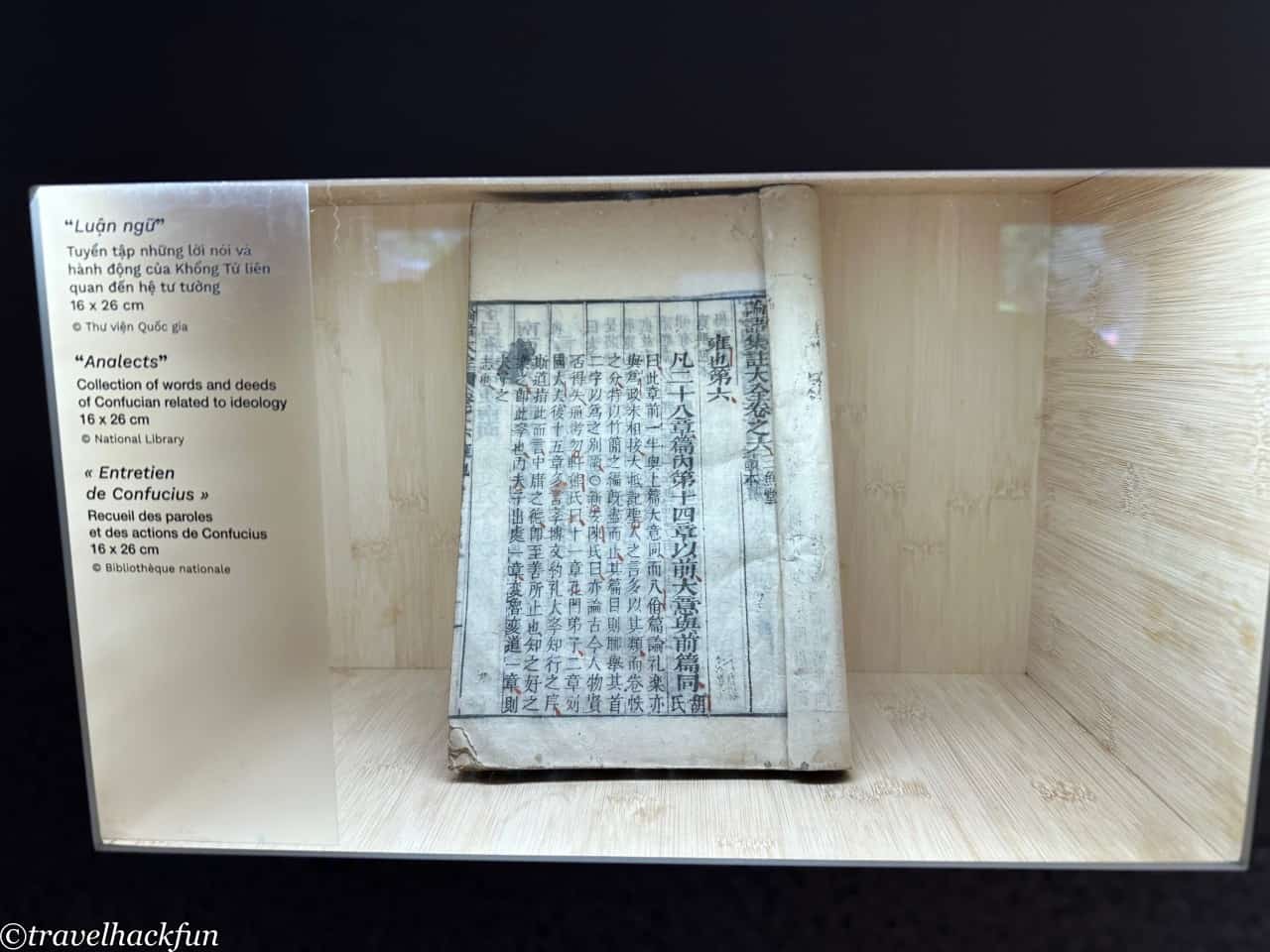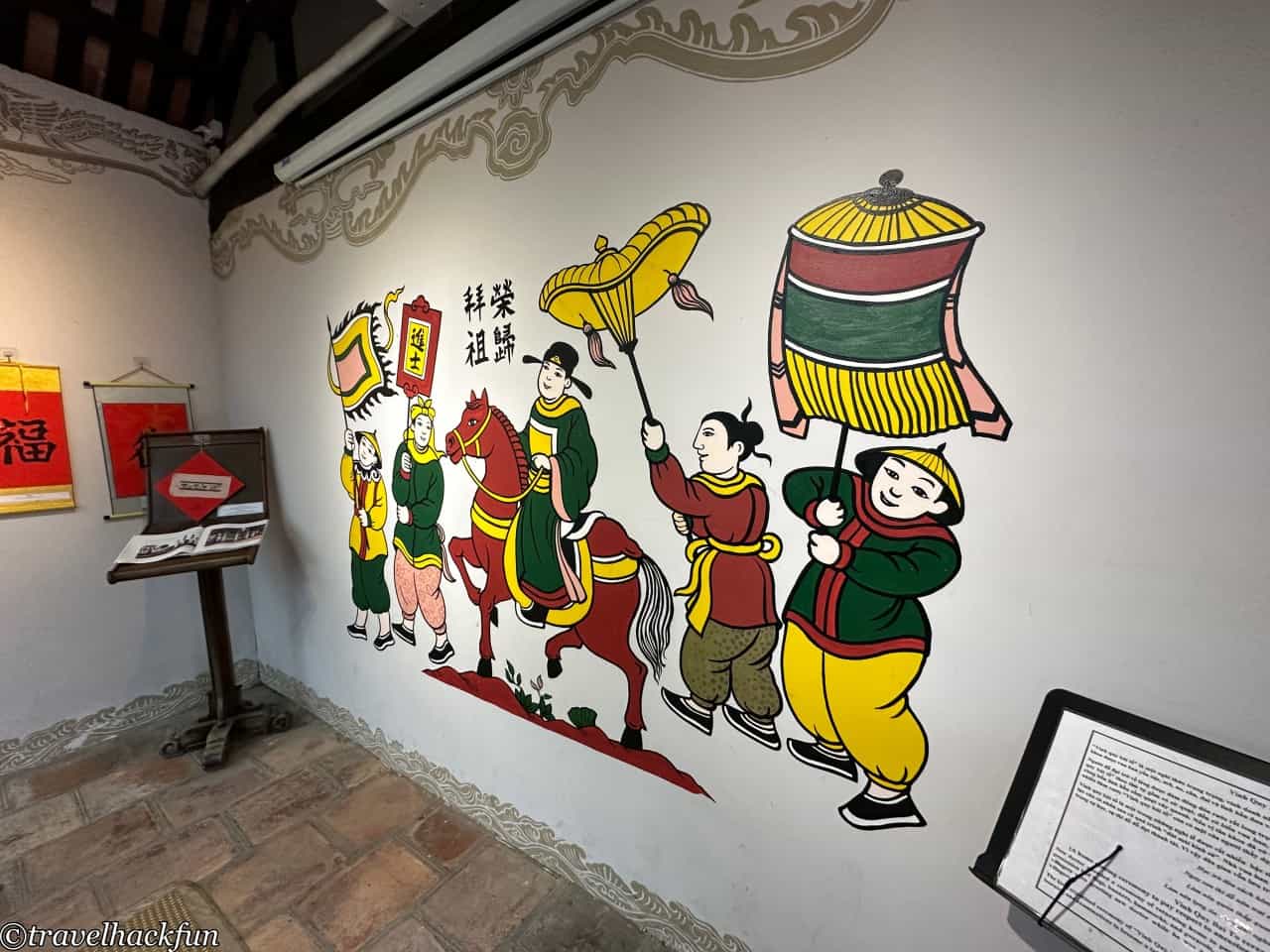Table of Content
Temple of Literature | Introduction
The Temple of Literature in Hanoi (Văn Miếu Hà Nội), also known as Hanoi's Confucius Temple, is one of the must-visit attractions in Hanoi. Vietnam is deeply influenced by Confucian culture, and there are twenty to thirty Temples of Literature throughout the country, with the one in Hanoi being the most famous. On the Vietnamese 100,000 dong banknote, one side is printed with the image of the Hanoi Temple of Literature.
The formal name of the Temple of Literature was first built in 1070, situated on the western side of the Sword Lake. The current Temple of Literature covers an area of 54,331 square meters and has undergone multiple renovations over the centuries. In the educational system in ancient Vietnam, the Imperial Academy serving as the highest educational institution, akin to a university. Therefore, the Temple of Literature in Hanoi is considered Vietnam's first national university, holding deep historical and cultural significance as a symbol of Vietnam's pursuit of scholarship, education, and knowledge.
Temple of Literature | Visiting Information
If you are staying near Hoan Kiem Lake, taking a Grab ride to the Temple of Literature takes only a ten-minute drive.
Find a stay in Hanoi
The admission fee for adults at the Temple of Literature is 30,000 Vietnamese dong, while students with valid student IDs can avail themselves of tickets at 15,000 Vietnamese dong. Children under 15 years old can enter for free. The Temple of Literature is open year-round, with summer hours (April to October) from 07:30 to 17:30 and winter hours (October to April) from 08:00 to 17:00. There is basic audio guide available at the temple by scanning the provided QR codes on-site.
Temple of Literature | Visiting Highlights
The Temple of Literature is a traditional Confucian temple complex, roughly consisting of five courtyards. The outermost entrance features a Four Pillar Gate made up of four large pillars. After passing through the Four Pillar Gate, visitors first come across the Temple of Literature Gate and then the Đại Trung Gate. The space between the Temple of Literature Gate and the Đại Trung Gate constitutes the first courtyard. From the Temple of Literature Gate, one can see a central gate flanked by smaller gates on both sides. This entrance was expanded during the 19th century under the Nguyen Dynasty. The central gate was used only when the emperor visited, while ordinary people would use the smaller gates on either side.
![Hanoi, Vietnam] Temple of Literature | Vietnam's First University | Confucius Temple | State Eunuch 1 temple of literature, Hanoi 1](https://blog.travelhackfun.com/wp-content/uploads/2024/01/Hanoi-375.jpeg)
![Hanoi, Vietnam] Temple of Literature | Vietnam's First University | Confucius Temple | State Eunuch 2 temple of literature, Hanoi 2](https://blog.travelhackfun.com/wp-content/uploads/2024/01/Hanoi-376.jpeg)
![Hanoi, Vietnam] Temple of Literature | Vietnam's First University | Confucius Temple | State Eunuch 3 temple of literature, Hanoi 3](https://blog.travelhackfun.com/wp-content/uploads/2024/01/Hanoi-380.jpeg)
Khuê Văn pavilion
After passing through the Đại Trung Gate, one enters the second courtyard. The focal point of the second courtyard is the Khuê Văn Pavilion, a red wooden pavilion built in 1805, supported by four main pillars at the base. The Khuê Văn Pavilion is situated at the center of the Temple of Literature, symbolizing the rising of the Kui (a reference to a star associated with literature and academic success) star, illuminating the world of letters. The pavilion's upper floor was also used for teaching in ancient times, while the smaller doors on either side represented different areas of study.

![Hanoi, Vietnam] Temple of Literature | Vietnam's first university | Confucius Temple | State Eunuch 5 temple of literature, Hanoi 5](https://blog.travelhackfun.com/wp-content/uploads/2024/01/Hanoi-384.jpeg)
![Hanoi, Vietnam] Temple of Literature | Vietnam's first university | Confucius Temple | State Eunuch 6 temple of literature, Hanoi 6](https://blog.travelhackfun.com/wp-content/uploads/2024/01/Hanoi-386.jpeg)
![Hanoi, Vietnam] Temple of Literature | Vietnam's first university | Confucius Temple | State Eunuch 7 temple of literature Hanoi](https://blog.travelhackfun.com/wp-content/uploads/2024/01/Hanoi-387.jpeg)
Turtle Steles
After passing through the Khuê Văn Pavilion, one enters the third courtyard, with paths on both sides leading to the forest of Turtle Steles. The Turtle Steles record the names of doctoral laureates from over 300 years of imperial examinations. Each stele is carried by a stone turtle, with 82 of them still existing today. The Turtle Steles are enshrined in the Temple of Literature, and the names inscribed on them are essentially the honor roll of the imperial examination, highlighting the Vietnamese culture's emphasis on academic and scholarly achievements. As for why turtles? In East Asian culture, turtles are generally considered symbols of longevity and wisdom. In Vietnamese culture, they also signify the harmony of heaven, earth, and humanity, with the turtle's shell representing heaven and its belly representing earth. Placing the steles on the backs of turtles expresses the hope that the scholars' honors will, like the turtle, withstand the test of time and be passed down through generations .
![Hanoi, Vietnam] Temple of Literature | Vietnam's first university | Confucius Temple | State Eunuch 8 temple of literature, Hanoi 7](https://blog.travelhackfun.com/wp-content/uploads/2024/01/Hanoi-393-1125x1500.jpeg)
![Hanoi, Vietnam] Temple of Literature | Vietnam's first university | Confucius Temple | State Eunuch 9 Temple of literature, Hanoi 8](https://blog.travelhackfun.com/wp-content/uploads/2024/01/Hanoi-394.jpeg)
Thiên Quang well
The pond in the center of the third courtyard is called Thiên Quang well (the Well of Heavenly Light), reflecting the monuments of scholars on both sides. It is also meant to show the purity of wisdom.
![Hanoi, Vietnam] Temple of Literature | Vietnam's First University | Confucius Temple | State Eunuch 10 temple of literature, Hanoi 9](https://blog.travelhackfun.com/wp-content/uploads/2024/01/Hanoi-388.jpeg)
![Hanoi, Vietnam] Temple of Literature | Vietnam's first university | Confucius Temple | State Eunuch 11 Temple of Literature, Hanoi 10](https://blog.travelhackfun.com/wp-content/uploads/2024/01/Hanoi-396.jpeg)
![Hanoi, Vietnam] Temple of Literature | Vietnam's First University | Confucius Temple | State Eunuch 12 temple of literature, Hanoi 11](https://blog.travelhackfun.com/wp-content/uploads/2024/01/Hanoi-397.jpeg)
Temple of Literature
The fourth courtyard is the widest because it is the ceremonial center of the entire complex, where rituals to Confucius are conducted. At the forefront is the Thượng Điện (Great Hall of Ceremony), where Confucius and his disciples are worshipped. The main hall features a plaque inscribed with "Teacher for All Ages,". The architectural style is closer to that of the Song dynasty, characterized by its double-eaved tile roofs, wooden structure, and dragon motif carvings. The most significant difference from Chinese temples is that here, Confucius is worshipped with incense and statues; accompanying him on both sides are his 4 most important students.
![Hanoi, Vietnam] Temple of Literature | Vietnam's First University | Confucius Temple | State Eunuch 13 temple of literature, Hanoi 12](https://blog.travelhackfun.com/wp-content/uploads/2024/01/Hanoi-421.jpeg)
![Hanoi, Vietnam] Temple of Literature | Vietnam's first university | Confucius Temple | State Eunuch 14 temple of literature, Hanoi 13](https://blog.travelhackfun.com/wp-content/uploads/2024/01/Hanoi-425.jpeg)
![Hanoi, Vietnam] Temple of Literature | Vietnam's First University | Confucius Temple | State Eunuch 15 Temple of literature, Hanoi 14](https://blog.travelhackfun.com/wp-content/uploads/2024/01/Hanoi-426.jpeg)
![Hanoi, Vietnam] Temple of Literature | Vietnam's first university | Confucius Temple | State Eunuch 16 temple of literature, Hanoi 15](https://blog.travelhackfun.com/wp-content/uploads/2024/01/Hanoi-422.jpeg)
![Hanoi, Vietnam] Temple of Literature | Vietnam's first university | Confucius Temple | State Eunuch 17 temple of literature, Hanoi 16](https://blog.travelhackfun.com/wp-content/uploads/2024/01/Hanoi-423.jpeg)
The buildings on both sides are now used for static displays. The building on the right displays the history of the Temple of Literature. The history of the Hanoi Temple of Literature dates back a thousand years to the 11th century. In 1010, when the capital was moved to the ancient city of Hoa Lu, Buddhism was the predominant religion. However, the Later Ly Dynasty government began to promote Taoism and Confucianism, and in 1070, the Temple of Literature was established at this location south of the Imperial City of Thang Long. The National Academy of Vietnam was founded in 1076, initially only for princes. It was not until the Tran Dynasty that the school expanded its enrollment to include talented individuals from common backgrounds. Despite changes in dynasties, until 1820 when the National Academy was moved to Hue, the Temple of Literature continuously functioned as a site for cultivating important national talents.
![Hanoi, Vietnam] Temple of Literature | Vietnam's First University | Confucius Temple | State Eunuch 18 temple of literature, Hanoi 17](https://blog.travelhackfun.com/wp-content/uploads/2024/01/Hanoi-402.jpeg)
The talent selection system in Vietnam was the imperial examination system. After the 15th century, the imperial examination was divided into four levels, starting from the initial examination through to the advanced scholar level. The final stage of the examination, for those achieving the rank of advanced scholar, was personally overseen by the emperor. The Temple of Literature, as the venue for holding the advanced scholar examinations, was also expanded to include lodgings capable of accommodating three hundred examinees, leading to the development of educational and crown prince supervisory institutions.
![Hanoi, Vietnam] Temple of Literature | Vietnam's first university | Confucius Temple | State Eunuch 19 temple of literature, Hanoi 18](https://blog.travelhackfun.com/wp-content/uploads/2024/01/Hanoi-406-1125x1500.jpeg)
![Hanoi, Vietnam] Temple of Literature | Vietnam's First University | Confucius Temple | State Eunuch 20 temple of literature, Hanoi 19](https://blog.travelhackfun.com/wp-content/uploads/2024/01/Hanoi-414-1125x1500.jpeg)
![Hanoi, Vietnam] Temple of Literature | Vietnam's First University | Confucius Temple | State Eunuch 21 Temple of literature, Hanoi 20](https://blog.travelhackfun.com/wp-content/uploads/2024/01/Hanoi-410-1125x1500.jpeg)

![Hanoi, Vietnam] Temple of Literature | Vietnam's first university | Confucius Temple | State Eunuch 23 Temple of literature, Hanoi 22](https://blog.travelhackfun.com/wp-content/uploads/2024/01/Hanoi-417-1125x1500.jpeg)
![Hanoi, Vietnam] Temple of Literature | Vietnam's First University | Confucius Temple | State Eunuch 24 temple of literature, Hanoi 23](https://blog.travelhackfun.com/wp-content/uploads/2024/01/Hanoi-418-1125x1500.jpeg)
The building on the left side hosts exhibitions related to the history of Vietnamese calligraphy. Like the Chinese, Vietnamese people value calligraphy highly. Even after transitioning from using Chinese characters to the Latin-based Vietnamese alphabet, the art of calligraphy was preserved, with the phonetic script still being practiced as calligraphy.
![Hanoi, Vietnam] Temple of Literature | Vietnam's First University | Confucius Temple | State Eunuch 25 temple of literature, Hanoi 24](https://blog.travelhackfun.com/wp-content/uploads/2024/01/Hanoi-429-1125x1500.jpeg)

![Hanoi, Vietnam] Temple of Literature | Vietnam's first university | Confucius Temple | State Eunuch 27 temple of literature, Hanoi 26](https://blog.travelhackfun.com/wp-content/uploads/2024/01/Hanoi-430-1125x1500.jpeg)

![Hanoi, Vietnam] Temple of Literature | Vietnam's First University | Confucius Temple | State Eunuch 29 Temple of literature, Hanoi 28](https://blog.travelhackfun.com/wp-content/uploads/2024/01/Hanoi-433.jpeg)
![Hanoi, Vietnam] Temple of Literature | Vietnam's First University | Confucius Temple | State Eunuch 30 temple of literature, Hanoi 29](https://blog.travelhackfun.com/wp-content/uploads/2024/01/Hanoi-431.jpeg)
Quốc Học Viện (Imperial Academy)
Behind the Great Hall of Ceremony, one can see the Imperial Academy, which has nurtured countless talents over the centuries. The Imperial Academy we see today is a reconstruction. After the original Imperial Academy was moved to Hue during the Nguyen Dynasty, the original site was once repurposed for worshipping Confucius's parents. Later, it was destroyed by artillery fire during the war with France. Now, the first floor venerates Chu Van An, a great master of Confucianism in Vietnam. The second floor is dedicated to three emperors who studied here and later became renowned as wise monarchs in Vietnamese history. The fifth courtyard, located in front of the Imperial Academy, is flanked by the Drum Tower on one side and the Bell Tower on the other.
![Hanoi, Vietnam] Temple of Literature | Vietnam's First University | Confucius Temple | State Eunuch 31 temple of literature, Hanoi 30](https://blog.travelhackfun.com/wp-content/uploads/2024/01/Hanoi-434.jpeg)
![Hanoi, Vietnam] Temple of Literature | Vietnam's First University | Confucius Temple | State Eunuch 32 temple of literature, Hanoi 31](https://blog.travelhackfun.com/wp-content/uploads/2024/01/Hanoi-438.jpeg)
![Hanoi, Vietnam] Temple of Literature | Vietnam's First University | Confucius Temple | State Eunuch 33 temple of literature, Hanoi 32](https://blog.travelhackfun.com/wp-content/uploads/2024/01/Hanoi-445.jpeg)
![Hanoi, Vietnam] Temple of Literature | Vietnam's First University | Confucius Temple | State Eunuch 34 temple of literature, Hanoi 33](https://blog.travelhackfun.com/wp-content/uploads/2024/01/Hanoi-440-1125x1500.jpeg)
![Hanoi, Vietnam] Temple of Literature | Vietnam's First University | Confucius Temple | State Eunuch 35 temple of literature, Hanoi 34](https://blog.travelhackfun.com/wp-content/uploads/2024/01/Hanoi-441-1125x1500.jpeg)
![Hanoi, Vietnam] Temple of Literature | Vietnam's First University | Confucius Temple | State Eunuch 36 Temple of literature, Hanoi 35](https://blog.travelhackfun.com/wp-content/uploads/2024/01/Hanoi-443.jpeg)
![Hanoi, Vietnam] Temple of Literature | Vietnam's First University | Confucius Temple | State Eunuch 37 temple of literature, Hanoi 36](https://blog.travelhackfun.com/wp-content/uploads/2024/01/Hanoi-450.jpeg)
Further reading
Thank you for visiting our website.
All the content on this site is original and shared with the purpose of providing valuable information. We sustain the operation of this site through a small amount of advertising and sponsored links. If you click on links to third-party merchants on our site and make purchases, we may receive a portion of the sales as a commission. If you click on links to third-party merchants on our site and make purchases, we may receive a portion of the sales as a commission.
Find more posts on a map Here.
My recommended resources for hotel bookings.
Recommended travel credit card for US-based travelers
Travel with just a backpack!
Buy me a coffee and support my contents!
If you are interested in quoting this article or using any part of its content and images on your website or publication, please contact us via email to request permission.
